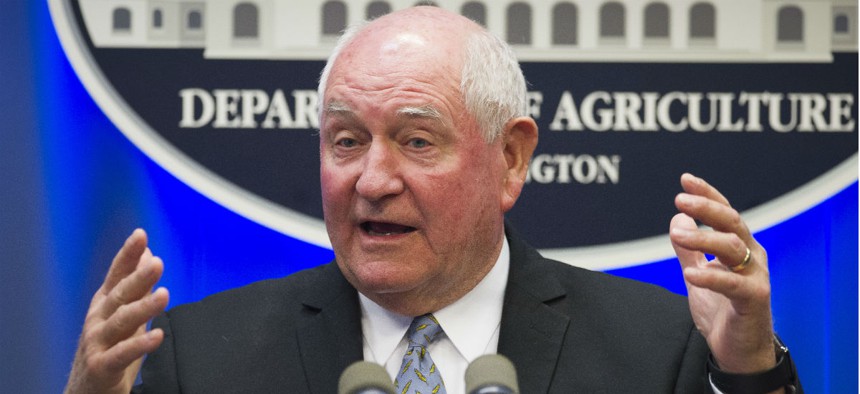
Agriculture Secretary Sonny Perdue announces an initiative in rural e-connectivity at the Agriculture Department earlier in December. Cliff Owen/AP
Agriculture Readies Second Round of Tariff-Related Farm Aid
Trump joins farm groups in welcoming money, with only a fraction delivered.
Agriculture Secretary Sonny Perdue on Monday won mostly plaudits from farm groups with his announcement of a “second and final round of trade mitigation payments aimed at assisting farmers suffering from damage due to unjustified trade retaliation by foreign nations.”
Coming just as the 2019 farm bill has cleared Congress and awaits a likely signature from President Trump, the new round of payments adds $9.6 billion to commodity producers hit by retaliatory tariffs from nations such as China. It follows the $12 billion in agency re-routed funds the administration announced in July after coming under fire for launching what some call a trade war.
“The president reaffirmed his support for American farmers and ranchers and made good on his promise, authorizing the second round of payments to be made in short order,” Perdue said in a statement. “While there have been positive movements on the trade front, American farmers are continuing to experience losses due to unjustified trade retaliation by foreign nations. This assistance will help with short-term cash flow issues as we move into the new year.”
The earlier rollout of the unusual initiative had been criticized for slow delivery and for allegedly tilting toward urban recipients rather than practicing farmers. An Agriculture Department spokesman told Government Executive on Tuesday that as of Monday, $2.3 billion out of the original $12 billion had been paid to farmers. The top receiving states are Illinois, Iowa, Kansas, Minnesota and Nebraska, and the top crops receiving the subsidies are soybeans, corn, wheat, dairy and sorghum.
Farmers must sign up and qualify by income for the payments. The sub-agencies running the programs include the Farm Service Agency, which administered direct payments to get food producers through the first half of their 2018 production; the Agricultural Marketing Service, whose food purchase and distribution program purchased up to $1.2 billion in commodities hit by foreign tariffs; the Foreign Agricultural Service’s Agricultural Trade Promotion program, which contributed $200 million to develop foreign markets; and the Food and Nutrition Service, which is distributing commodities through nutrition assistance programs.
Trump tweeted in celebration on Monday: “Today I am making good on my promise to defend our Farmers & Ranchers from unjustified trade retaliation by foreign nations. I have authorized Secretary Perdue to implement the 2nd round of Market Facilitation Payments. Our economy is stronger than ever–we stand with our Farmers!”
The new payments were also welcomed by the American Farm Bureau Federation. “This latest trade mitigation package announcement will help our farmers and ranchers weather the continuing trade storm,” said President Zippy Duvall.
“We continue to feel price pressure and very real economic damage due to the trade actions other nations have taken against our U.S. farm exports,” he added. “While this assistance package will help a number of our farm families during this year of severe economic challenge, the best way to provide lasting relief is to continue pushing for trade and tariff reform from trading partners like China, Canada, Mexico, India, Turkey and the European Union.”
The National Milk Producers Association had a mixed reaction. “The tariff-mitigation payment for dairy farmers in this second round of payments is less than we had hoped for, but it will provide some assistance during difficult times,” said President and CEO Jim Mulhern. “The tit-for-tat tariffs that prompted these mitigation payments continue to inflict damage across the farm economy.”
Also disappointed in the size of the payments was the National Corn Growers Association. “One cent per bushel is woefully inadequate to even begin to cover the losses being felt by corn farmers,” said President Lynn Chrisp, in a release. “USDA did not take into account the reality that many of our farmers are facing” right now.
The nonprofit Environmental Working Group, which advocates and educates on health issues, had on Nov. 19 released a critical analysis of the earlier round of payments. “Unfortunately, President Trump’s farmer bailout program is not necessarily helping the farmers most threatened by his escalating trade war,” the group's communications deputy director, Sarah Graddy, told Government Executive on Tuesday.
Environmental Working Group research using USDA data show that, so far, more than 1,000 city dwellers have received “bailout money” and the top 10 percent of all recipients have received 68 percent of all funds, she said. “These numbers match trends EWG has been tracking for years, which indicate that federal farm subsidies tend to benefit the largest, most financially secure farmers–or those who have a financial interest in a farm, but may never set a foot on it, let alone drive a tractor.”







